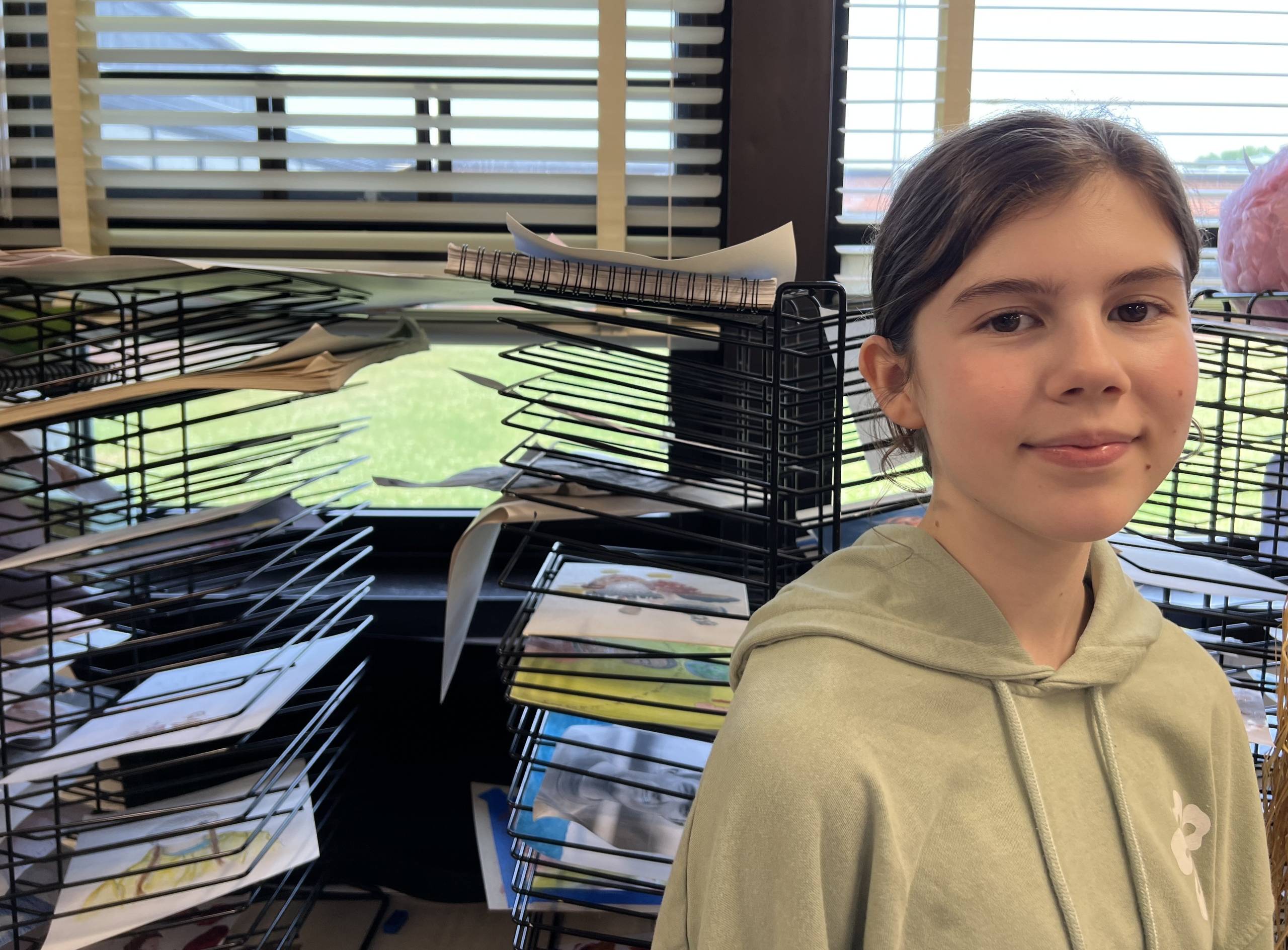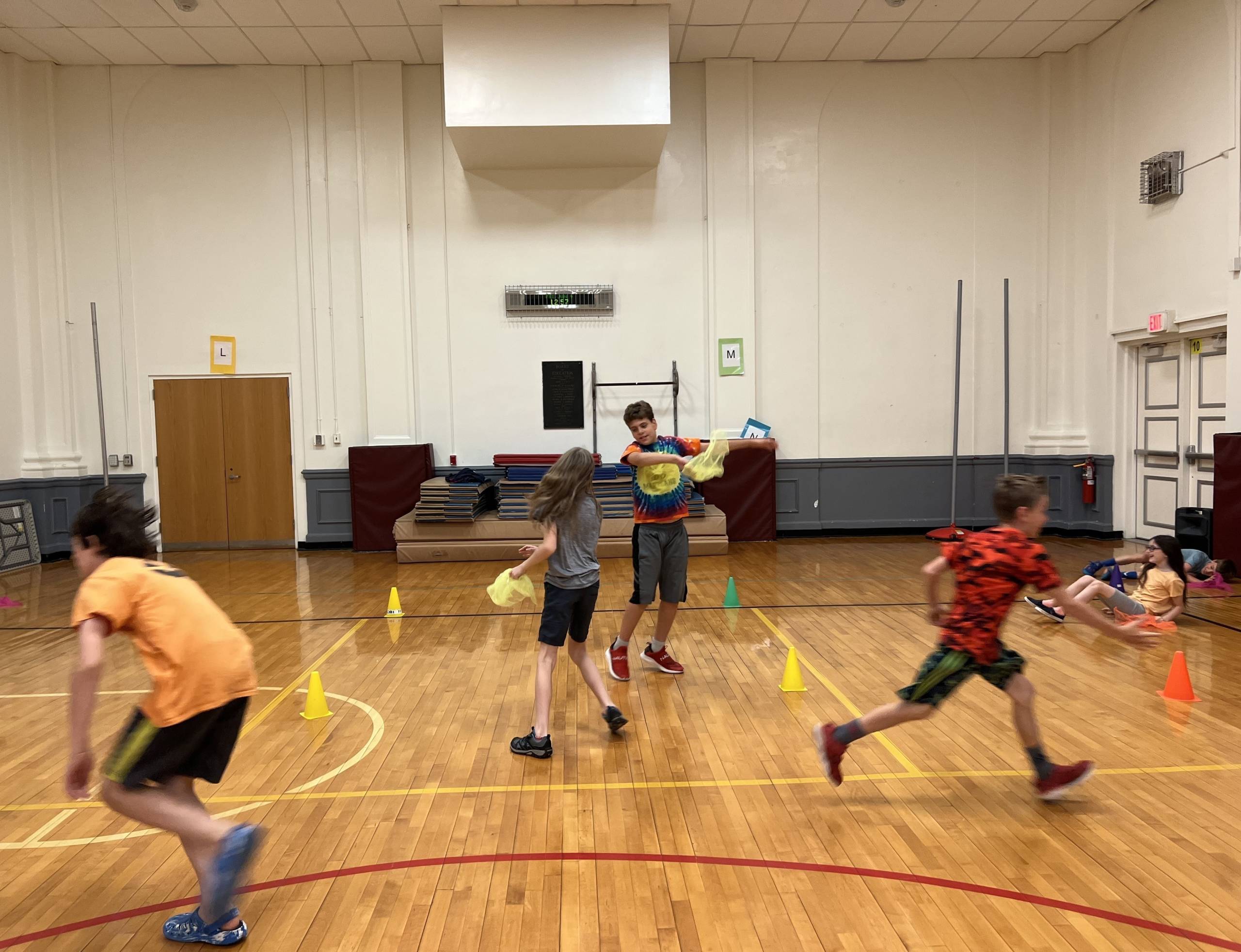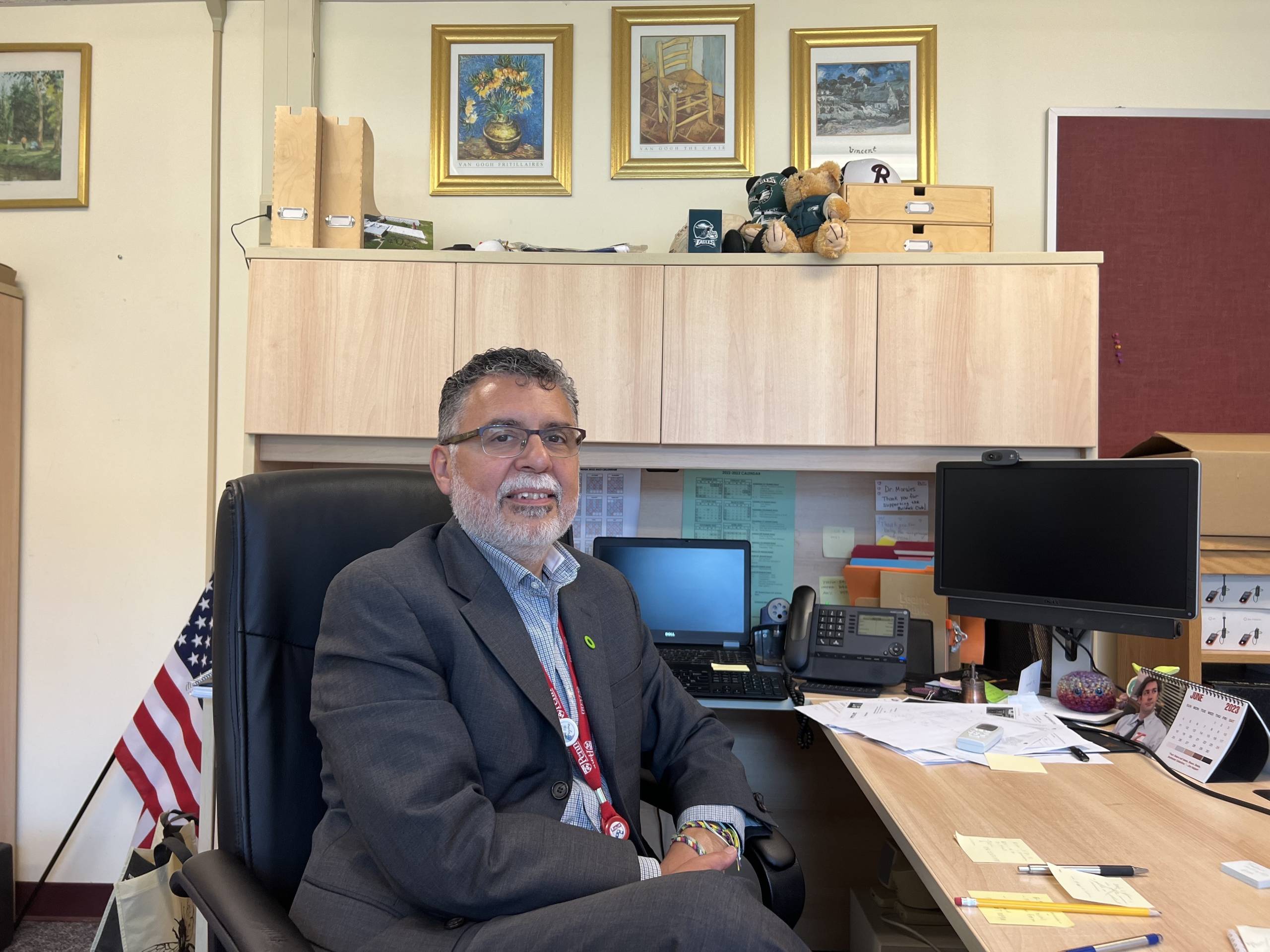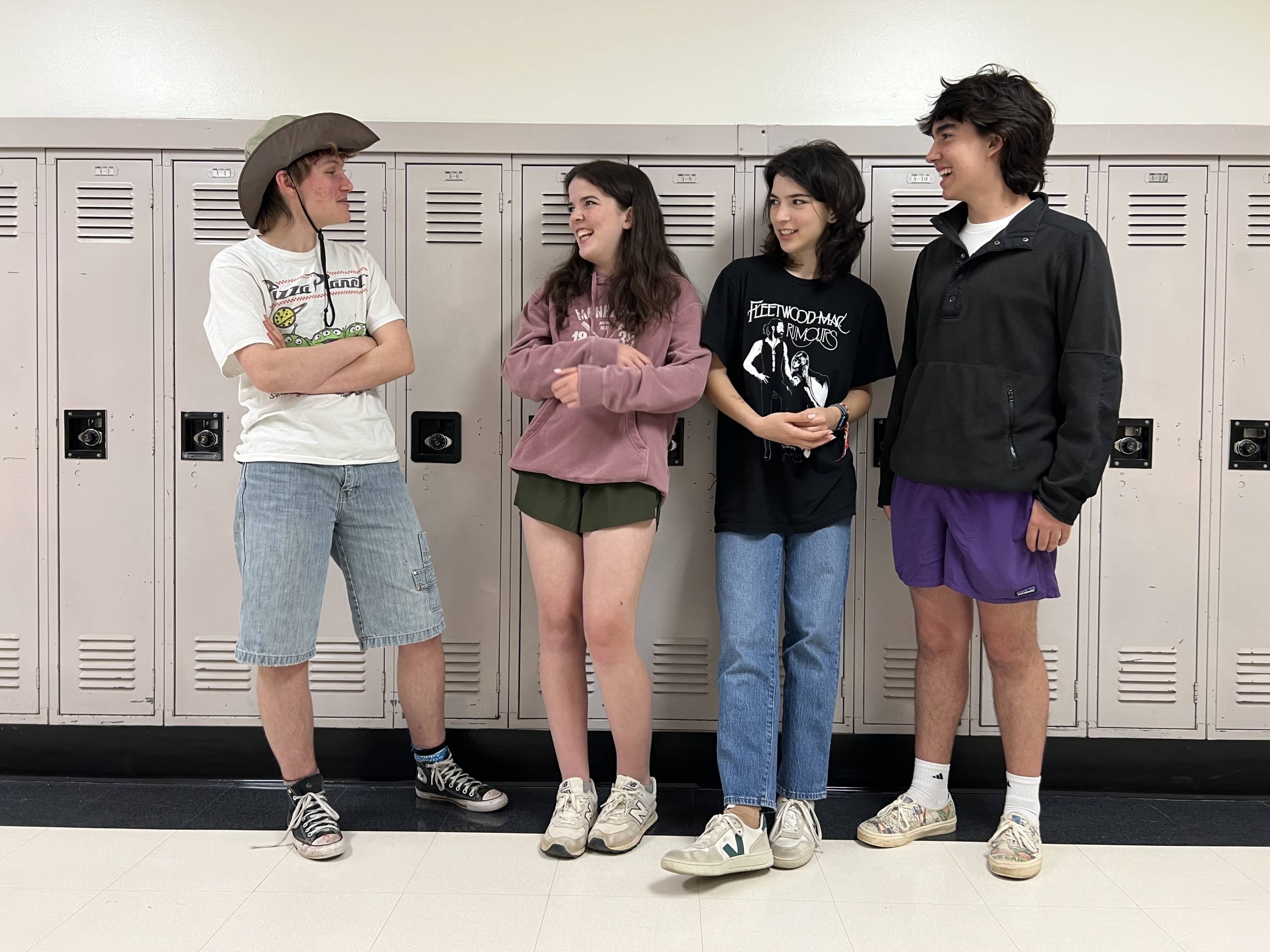Evelyn Lansing, a senior at Hopewell Valley Central High School in Pennington, N.J., brushed purple glaze onto her clay tile as the school year came to an end in June.
Lansing and her classmates had spent weeks researching the impacts of human-caused climate change on their communities and their own lives. Their bas-relief tiles and the three-dimensional images sculpted onto them represented something each of them learned.
Lansing’s tile featured a blueberry branch – a nod to the rich agricultural heritage of New Jersey, which has earned it the nickname “the garden state.”
“A lot of those things that we are used to seeing aren’t going to be able to be grown here with the continuing climate change,” said Lansing, who comes from a family that grows their own food.
New Jersey – a state with roughly 130-miles of coastline – is already confronting multiple climate realities, from more frequent flooding and extreme heat to air pollution from wildfire smoke in Canada.
In New Jersey classrooms, students are facing these realities head on. In 2020, the state became the first in the country to adopt standards requiring climate change to be taught across grade levels and in nearly all subjects in K-12 public schools.
Those standards were rolled out last year, including in the ceramics class at Hopewell Valley Central High.
Students in the class, like freshman Devin Brown, discovered that climate change threatens the state’s biodiversity. Brown grew up catching and releasing crayfish in New Jersey streams. She learned through her research that climate change is endangering their habitat, so she sculpted a crayfish onto her clay tile.

Left: Hopewell Valley Central High School freshman Devin Brown’s tile shows a crayfish – several species of which are currently endangered – to show how climate change is threatening New Jersey’s biodiversity. Right: Senior Evelyn Lansing’s tile features a blueberry branch, a popular berry in New Jersey, to communicate her concerns about the effects of climate change on agriculture. (Carolyn McGrath)
“I think art is a really powerful way to spread awareness about climate change,” Brown said. “And I think it can really connect to parts of people that studies and articles do not.”
Brown and Lansing’s art teacher Carolyn McGrath said she encourages students to think of art as a tool.
“How do we use art to address climate change, or how do we use art to explore feelings about climate change or to communicate about climate change or to motivate people to do something about climate change, right? So, this is the power of art,” McGrath said.
Lauren Madden, a professor of elementary science education at The College of New Jersey, advised the New Jersey Department of Education and First Lady Tammy Murphy’s office as they developed the new standards.
Climate change instruction in K-12 schools is long overdue, Madden said.
“We’ve decided to take young children seriously. We’ve decided that this is something we can unpack in the early years,” she said.
To promote climate literacy, especially in the early years of school, climate change education should be accessible, Madden said. Climate change education doesn’t have to be complex for young students to understand what it means.
“We can really get into a lot of the foundational information, looking at graphs and photographs and maps and places that things have changed over time and get into some of that solution-building at an earlier age,” Madden said.
New Jersey set aside $4.5 million in grants in 2023 to support and train educators and ensure students in underserved districts also have access to climate change education. The state has appropriated another $5 million toward climate change education in its 2024 fiscal year budget, New Jersey Department of Education spokesperson Laura Fredrick said.
The New Jersey Climate Education Hub also helps teachers by sharing instructional materials that educators working across different subject areas can use.
Other states, like Connecticut, are trying to follow in New Jersey’s footsteps.

Hopewell Valley Central High School freshman Devin Brown said that learning about climate change this school year has made her feel that she can make a difference. “I just think about how the small things really impact and how everyone has the ability to really impact and help our earth,” she said. (Seyma Bayram/NPR)
Now, students learn about climate change not only in McGrath’s ceramics class, but in most subjects including physical education.
In Suzanne Horsley’s wellness class at Toll Gate Grammar School in Pennington, students sit in a circle in the gym. Horsley’s students are usually outside, but on this day, they are indoors because of wildfire smoke.
“We just experienced this week some very interesting air quality, correct?,” Horsley asks the class. The students nod and chant “Yes” in unison.
Smoke from Canadian wildfires has swept across much of the northeast and other parts of the country this summer, including New Jersey. In Pennington, the air quality index in June had reached hazardous levels.
“We are experiencing that and that impacts our health,” Horsley explained to her students. She then launched into a lesson on the carbon cycle and the impacts of air pollution on the cardiorespiratory system.
The game Horsley’s students played on that June day helped them understand the impacts of wildfire smoke on air quality and on the body.
The students were stationed in pairs in colored zones in the gym – yellow, orange and pink. The colors represented different air quality zones, with pink being the worst.
The students threw same-colored scarves in the air to their partner who then had to run to catch the scarf.
Students in the pink zone had to run the farthest.
Fourth grader Charlie Belli said moving helps him deal with his own anxiety about climate change.
“Running around makes me feel, like, less stressed about climate change,” Belli said.

In Suzanne Horsley’s wellness classes at Toll Gate Grammar School in Pennington, N.J., elementary students learn about the health impacts of climate change. They play games that demonstrate what they have learned. (Seyma Bayram/NPR)
A study published in July by the Yale Program on Climate Change Communication found that at least 7% of American adults experience some form of psychological distress due to climate change. Younger adults and Hispanic populations reported the highest levels of psychological distress related to climate change according to the report.
“Climate change, it’s a part of the lives of the students these days, so really every possible subject area that can teach it should be teaching it,” Horsley said.
She emphasized the importance of teaching climate change across different subject areas – not only because climate change impacts all aspects of young people’s lives, but also because each student has a different learning style.
“Teaching it in wellness class in addition to other subject areas allows students who are passionate in one subject or another to find perhaps new knowledge in a way that would be more appropriate for them,” Horsley said.
Not everyone thinks climate change should be taught in schools.
Conservative states like Idaho and Texas have pushed back on such instruction in K-12 schools in recent years.
In Idaho, the state legislature repeatedly rejected learning standards that mentioned climate change.
In Texas, the state board of education issued guidance to schools last spring encouraging them to highlight the “positive” aspects of the fossil fuel industry in instructional materials.
After an outcry from the school board earlier this year, the Kutztown School District in Pennsylvania banned a popular young adult novel about middle schoolers navigating climate disasters.
The pushback has also extended to college campuses. A senate bill in Ohio this year would require public university and college professors to teach the “scientific strengths and weaknesses” of climate change, despite the overwhelming scientific consensus on climate change.
All of this is happening despite studies that show most parents in the nation favor climate change being taught in schools.
A 2019 NPR and Ipsos poll found that more than 80% of parents nationwide supported climate change instruction.
The resistance to climate change instruction is not an accident, said investigative reporter Katie Worth who wrote a book on how climate change is taught in America.
She traces the pushback against climate education to the fossil fuel industry and its decades-long effort to sow doubt about climate change.
“We know from memos that came from the industry that they literally thought about how to get kids to doubt climate change. There was a meeting in which leaders of the fossil fuel industry got together and they discussed ‘how are we going to get our messages in front of kids?’ And they succeeded at that,” Worth said.
The results of those efforts, she said, are evident in textbooks and learning standards that undermine the science of, or scientific consensus on, climate change.
Sowing doubt about climate change, Worth said, allows the fossil fuel industry to maintain its business interests.
“If you seed that into kids, you’re protecting your business in the future, too, because now you’re creating future doubters about climate change and it really pays off,” Worth said.
Even in New Jersey, where 70% of residents support climate change education, some parents oppose it.

Albert Morales, assistant principal at Rosa International Middle School in Cherry Hill, N.J., said state-mandated climate change instruction protects teachers and students from efforts to deny climate change education. (Seyma Bayram/NPR)
The state’s standards apply to seven subjects, with plans to expand into English Language Arts and math classes.
At a public hearing in May, members of a group called Team Protect Your Children spoke out against those plans.
Kathleen Kirk was one of them. She took issue with elementary students learning about climate change, which she described as a “theory” during the hearing.
“Climate change is based on weak science,” Kirk said.
Comments like Kirk’s are why state-mandated climate change instruction is important, said Albert Morales, assistant principal at Rosa International Middle School in Cherry Hill, N.J.
Morales said state-mandated climate change instruction protects students and teachers from efforts to deny climate education.
“Because we are a public school and if they are in the standards, then those are things that we are mandated to teach,” Morales said. “So I think the fact that New Jersey has those standards is in a way a protection that allows us to teach about what’s actually happening.”
Horsley, who teaches the wellness class at Toll Gate Grammar School, said before New Jersey adopted the standards, she worried about teaching climate change.
“I didn’t want to get in hot water, if you will, in a district that maybe thought this wasn’t appropriate,” Horsley recalled. “So the second it became our standard, it was something I was anxious and quick to jump on.”
For students in New Jersey, like junior Lucy Webster at Hopewell Valley Central High, climate change education has been empowering.
Webster still thinks about the first time she learned about climate change, long before the state mandate.
“As a little kid, I was really scared of the changes in the extreme weather that was going on around me and missing school because of hurricanes,” she said.
Her 5th grade science teacher Helen Corveleyn helped.

Left to right: Iris Lautermilch, Tabitha Webster, Lucy Webster and Benjamin Pollara are members of the Youth Environmental Society at Hopewell Valley Central High School in Pennington, N.J. The group wants to see climate change taught in every class at their school. (Seyma Bayram/NPR)
“Her telling me why these were happening made me feel like I could do something about it even though I was like 11,” Webster said.
Today, Webster helps lead the Youth Environmental Society at her high school.
The group, which McGrath mentors, is working on a climate action plan with parents, teachers and students. Their goals include getting their school to transition to electric buses and to train guidance counselors in climate mental health awareness.
The students also want climate change to be taught in every classroom.
In June, the group wrote a letter to the New Jersey Board of Education urging the board to adopt the new English Language Arts and math standards that would include climate change. The board is reviewing the standards and an official vote has not been set.
Copyright 2023 NPR. To see more, visit https://www.npr.org.
9(MDAxOTAwOTE4MDEyMTkxMDAzNjczZDljZA004))
Continue reading...
Lansing and her classmates had spent weeks researching the impacts of human-caused climate change on their communities and their own lives. Their bas-relief tiles and the three-dimensional images sculpted onto them represented something each of them learned.
Lansing’s tile featured a blueberry branch – a nod to the rich agricultural heritage of New Jersey, which has earned it the nickname “the garden state.”
“A lot of those things that we are used to seeing aren’t going to be able to be grown here with the continuing climate change,” said Lansing, who comes from a family that grows their own food.
New Jersey – a state with roughly 130-miles of coastline – is already confronting multiple climate realities, from more frequent flooding and extreme heat to air pollution from wildfire smoke in Canada.
In New Jersey classrooms, students are facing these realities head on. In 2020, the state became the first in the country to adopt standards requiring climate change to be taught across grade levels and in nearly all subjects in K-12 public schools.
Those standards were rolled out last year, including in the ceramics class at Hopewell Valley Central High.
Students in the class, like freshman Devin Brown, discovered that climate change threatens the state’s biodiversity. Brown grew up catching and releasing crayfish in New Jersey streams. She learned through her research that climate change is endangering their habitat, so she sculpted a crayfish onto her clay tile.

Left: Hopewell Valley Central High School freshman Devin Brown’s tile shows a crayfish – several species of which are currently endangered – to show how climate change is threatening New Jersey’s biodiversity. Right: Senior Evelyn Lansing’s tile features a blueberry branch, a popular berry in New Jersey, to communicate her concerns about the effects of climate change on agriculture. (Carolyn McGrath)
“I think art is a really powerful way to spread awareness about climate change,” Brown said. “And I think it can really connect to parts of people that studies and articles do not.”
Brown and Lansing’s art teacher Carolyn McGrath said she encourages students to think of art as a tool.
“How do we use art to address climate change, or how do we use art to explore feelings about climate change or to communicate about climate change or to motivate people to do something about climate change, right? So, this is the power of art,” McGrath said.
Setting the standards
Lauren Madden, a professor of elementary science education at The College of New Jersey, advised the New Jersey Department of Education and First Lady Tammy Murphy’s office as they developed the new standards.
Climate change instruction in K-12 schools is long overdue, Madden said.
“We’ve decided to take young children seriously. We’ve decided that this is something we can unpack in the early years,” she said.
To promote climate literacy, especially in the early years of school, climate change education should be accessible, Madden said. Climate change education doesn’t have to be complex for young students to understand what it means.
“We can really get into a lot of the foundational information, looking at graphs and photographs and maps and places that things have changed over time and get into some of that solution-building at an earlier age,” Madden said.
New Jersey set aside $4.5 million in grants in 2023 to support and train educators and ensure students in underserved districts also have access to climate change education. The state has appropriated another $5 million toward climate change education in its 2024 fiscal year budget, New Jersey Department of Education spokesperson Laura Fredrick said.
The New Jersey Climate Education Hub also helps teachers by sharing instructional materials that educators working across different subject areas can use.
Other states, like Connecticut, are trying to follow in New Jersey’s footsteps.

Hopewell Valley Central High School freshman Devin Brown said that learning about climate change this school year has made her feel that she can make a difference. “I just think about how the small things really impact and how everyone has the ability to really impact and help our earth,” she said. (Seyma Bayram/NPR)
An interdisciplinary approach to climate education
Now, students learn about climate change not only in McGrath’s ceramics class, but in most subjects including physical education.
In Suzanne Horsley’s wellness class at Toll Gate Grammar School in Pennington, students sit in a circle in the gym. Horsley’s students are usually outside, but on this day, they are indoors because of wildfire smoke.
“We just experienced this week some very interesting air quality, correct?,” Horsley asks the class. The students nod and chant “Yes” in unison.
Smoke from Canadian wildfires has swept across much of the northeast and other parts of the country this summer, including New Jersey. In Pennington, the air quality index in June had reached hazardous levels.
“We are experiencing that and that impacts our health,” Horsley explained to her students. She then launched into a lesson on the carbon cycle and the impacts of air pollution on the cardiorespiratory system.
The game Horsley’s students played on that June day helped them understand the impacts of wildfire smoke on air quality and on the body.
The students were stationed in pairs in colored zones in the gym – yellow, orange and pink. The colors represented different air quality zones, with pink being the worst.
The students threw same-colored scarves in the air to their partner who then had to run to catch the scarf.
Students in the pink zone had to run the farthest.
Fourth grader Charlie Belli said moving helps him deal with his own anxiety about climate change.
“Running around makes me feel, like, less stressed about climate change,” Belli said.

In Suzanne Horsley’s wellness classes at Toll Gate Grammar School in Pennington, N.J., elementary students learn about the health impacts of climate change. They play games that demonstrate what they have learned. (Seyma Bayram/NPR)
A study published in July by the Yale Program on Climate Change Communication found that at least 7% of American adults experience some form of psychological distress due to climate change. Younger adults and Hispanic populations reported the highest levels of psychological distress related to climate change according to the report.
“Climate change, it’s a part of the lives of the students these days, so really every possible subject area that can teach it should be teaching it,” Horsley said.
She emphasized the importance of teaching climate change across different subject areas – not only because climate change impacts all aspects of young people’s lives, but also because each student has a different learning style.
“Teaching it in wellness class in addition to other subject areas allows students who are passionate in one subject or another to find perhaps new knowledge in a way that would be more appropriate for them,” Horsley said.
Pushback against climate change education
Not everyone thinks climate change should be taught in schools.
Conservative states like Idaho and Texas have pushed back on such instruction in K-12 schools in recent years.
In Idaho, the state legislature repeatedly rejected learning standards that mentioned climate change.
In Texas, the state board of education issued guidance to schools last spring encouraging them to highlight the “positive” aspects of the fossil fuel industry in instructional materials.
After an outcry from the school board earlier this year, the Kutztown School District in Pennsylvania banned a popular young adult novel about middle schoolers navigating climate disasters.
The pushback has also extended to college campuses. A senate bill in Ohio this year would require public university and college professors to teach the “scientific strengths and weaknesses” of climate change, despite the overwhelming scientific consensus on climate change.
All of this is happening despite studies that show most parents in the nation favor climate change being taught in schools.
A 2019 NPR and Ipsos poll found that more than 80% of parents nationwide supported climate change instruction.
The resistance to climate change instruction is not an accident, said investigative reporter Katie Worth who wrote a book on how climate change is taught in America.
She traces the pushback against climate education to the fossil fuel industry and its decades-long effort to sow doubt about climate change.
“We know from memos that came from the industry that they literally thought about how to get kids to doubt climate change. There was a meeting in which leaders of the fossil fuel industry got together and they discussed ‘how are we going to get our messages in front of kids?’ And they succeeded at that,” Worth said.
The results of those efforts, she said, are evident in textbooks and learning standards that undermine the science of, or scientific consensus on, climate change.
Sowing doubt about climate change, Worth said, allows the fossil fuel industry to maintain its business interests.
“If you seed that into kids, you’re protecting your business in the future, too, because now you’re creating future doubters about climate change and it really pays off,” Worth said.
Even in New Jersey, where 70% of residents support climate change education, some parents oppose it.

Albert Morales, assistant principal at Rosa International Middle School in Cherry Hill, N.J., said state-mandated climate change instruction protects teachers and students from efforts to deny climate change education. (Seyma Bayram/NPR)
The state’s standards apply to seven subjects, with plans to expand into English Language Arts and math classes.
At a public hearing in May, members of a group called Team Protect Your Children spoke out against those plans.
Kathleen Kirk was one of them. She took issue with elementary students learning about climate change, which she described as a “theory” during the hearing.
“Climate change is based on weak science,” Kirk said.
Comments like Kirk’s are why state-mandated climate change instruction is important, said Albert Morales, assistant principal at Rosa International Middle School in Cherry Hill, N.J.
Morales said state-mandated climate change instruction protects students and teachers from efforts to deny climate education.
“Because we are a public school and if they are in the standards, then those are things that we are mandated to teach,” Morales said. “So I think the fact that New Jersey has those standards is in a way a protection that allows us to teach about what’s actually happening.”
Horsley, who teaches the wellness class at Toll Gate Grammar School, said before New Jersey adopted the standards, she worried about teaching climate change.
“I didn’t want to get in hot water, if you will, in a district that maybe thought this wasn’t appropriate,” Horsley recalled. “So the second it became our standard, it was something I was anxious and quick to jump on.”
Climate change education resonates with students
For students in New Jersey, like junior Lucy Webster at Hopewell Valley Central High, climate change education has been empowering.
Webster still thinks about the first time she learned about climate change, long before the state mandate.
“As a little kid, I was really scared of the changes in the extreme weather that was going on around me and missing school because of hurricanes,” she said.
Her 5th grade science teacher Helen Corveleyn helped.

Left to right: Iris Lautermilch, Tabitha Webster, Lucy Webster and Benjamin Pollara are members of the Youth Environmental Society at Hopewell Valley Central High School in Pennington, N.J. The group wants to see climate change taught in every class at their school. (Seyma Bayram/NPR)
“Her telling me why these were happening made me feel like I could do something about it even though I was like 11,” Webster said.
Today, Webster helps lead the Youth Environmental Society at her high school.
The group, which McGrath mentors, is working on a climate action plan with parents, teachers and students. Their goals include getting their school to transition to electric buses and to train guidance counselors in climate mental health awareness.
The students also want climate change to be taught in every classroom.
In June, the group wrote a letter to the New Jersey Board of Education urging the board to adopt the new English Language Arts and math standards that would include climate change. The board is reviewing the standards and an official vote has not been set.
Copyright 2023 NPR. To see more, visit https://www.npr.org.
9(MDAxOTAwOTE4MDEyMTkxMDAzNjczZDljZA004))
Continue reading...

